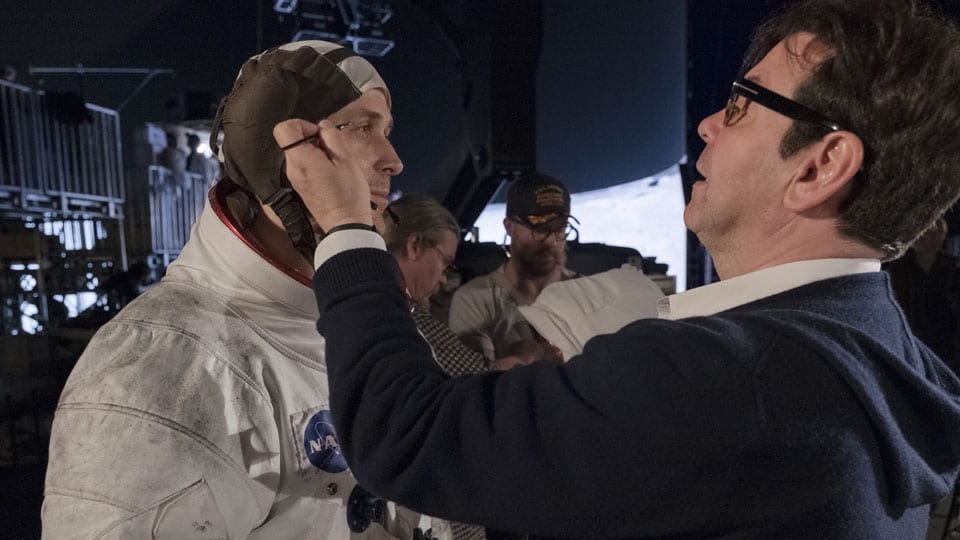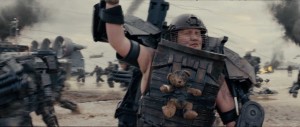
Tom Cruise has been facilitating starring vehicles for himself seemingly once a year now for the better part of the past decade. This year, he has embraced a much darker, grittier movie. Edge of Tomorrow, the film adaptation of author Hiroshi Sakurazaka‘s novel All You Need Is Kill, directed by Doug Liman and starring Cruise and Emily Blunt, portrays the recurring struggles Cruise’s character must face in order to fend off an invasion from an alien race known as the “Mimics.” The film employs elements of suspense present in previous Liman films, mated with a sci-fi “time-loop” plot sure to remind audiences of Groundhog Day. To bring this concept to life, Liman needed to entrust much of his film’s visual fate to the able hands of a renowned staff. Enter Daniel Kramer, VFX supervisor for Sony Pictures Imageworks. Kramer, a veteran visual effects artist, has been hailed for his past work on films such as Independence Day, Watchmen, and Spider-Man. With Kramer at the helm, Sony Pictures Imageworks would be tasked with bringing the majority of Edge of Tomorrow‘s visual effects sequences to life. With help from supervisor Nick Davis (The Dark Night), Kramer began immediate work on creating the conceptual art for the film.
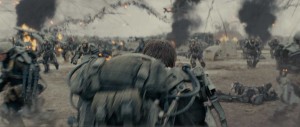 “When I came on, quite a bit of work had already been done to figure out what the opening landing shot would look like,” Kramer said. “We were brought on right at the time when they first started shooting. I had finished Hotel Transylvania and found out that we landed the job. I had to get on set really quick, because they had a lot of the previews and concept designs done already. We had seen this when it was proposed to us.”
“When I came on, quite a bit of work had already been done to figure out what the opening landing shot would look like,” Kramer said. “We were brought on right at the time when they first started shooting. I had finished Hotel Transylvania and found out that we landed the job. I had to get on set really quick, because they had a lot of the previews and concept designs done already. We had seen this when it was proposed to us.”
For Kramer, the challenge would be to develop graphics for art director, Neil Lamont, while Liman was still working through the script.“The script was ever-evolving,” Kramer recalled. “Doug Liman was finding his way through the script and story. The third act was not fleshed out when we started working on it. We didn’t know what the alien looked like. It ended up being different while we were shooting.”
Building a memorable action sequence is no easy task, and Kramer and his Imageworks team needed to create a variety of items that would be appropriate for the opening action sequence in the hopes that there would be an organic sense of continuity throughout the film.“We worked closely on the layout and littered the beach with dead bodies, planes being hit, and spaceships falling from the sky,” Kramer described. “They didn’t know the tone of the movie at that time. I worked on location with Nick for a couple of months. Imageworks was responsible for the main two acts – the Heathrow work and extension as well as the beach shots, trailer park and helicopter in the barn. That was all done at Leavesden Studios in London. Then, we embarked on assets [including] semi-automated guns that come off of his back as he gets a little bit better. We got designs for the ships, huge landing vehicles, boats and aircraft carriers. We got a list of everything we needed to build. We modeled those when I was on location. The DFX [supervisor, Ken Hahn] helped out organizing the efforts in Culver City.”
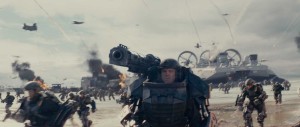 During the asset building process, Kramer and his team were able to create the appearance of a convincing war without tailoring scenes to any one specific shot. It was a technique that proved efficient. “It’s a very long process to build the assets to get to the point of rendering a shot,” Kramer explained. “We made a lo-res proxy version of each of them. We got a scan of the beach and built an environment. We gave versions to the art department. We got plates from production, got those 3D match-moved and loaded into our layout. The action was so disorienting that we could get away with murder as far as continuity goes. We had tons of boats landing on the beach as they dropped off troops and left, as well as crowds of troops running up the beach. The layout department built up a general war action sequence.”
During the asset building process, Kramer and his team were able to create the appearance of a convincing war without tailoring scenes to any one specific shot. It was a technique that proved efficient. “It’s a very long process to build the assets to get to the point of rendering a shot,” Kramer explained. “We made a lo-res proxy version of each of them. We got a scan of the beach and built an environment. We gave versions to the art department. We got plates from production, got those 3D match-moved and loaded into our layout. The action was so disorienting that we could get away with murder as far as continuity goes. We had tons of boats landing on the beach as they dropped off troops and left, as well as crowds of troops running up the beach. The layout department built up a general war action sequence.”
As most big action films shoot against green, SPI has a pipeline in place for adding background elements to live-action plates with greenscreen backgrounds. “We populated our CG world where the set stopped and the greenscreen started,” Kramer stated. “By doing that, we could then load in the match-move cameras for a sequence. We had a convincing war without tailoring anything for any one specific shot. We can stick a dead body in the plate or a hole in the plate where we can put in some CG guys or have a tank drive through. That was choreographed and puzzled for each shot. We had assets, pre-canned clips we could drop in. A lot of it was big gas explosions, giant plumes of smoke rising, javelins rising through the air, matching live-action reference on set, making little clips of animation and rendering them from different angles.”
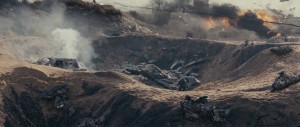 By merging live-action effects with CGI rendered visuals, Kramer and his team were able to combine the two elements seamlessly into the film. “By combining live-action, pyro, and digital versions of pyro, we could generate more views of the different explosions,” he said. “They could start layering them in and matting them into each scene. In addition to the live-action pyro and generated pyro that we created, we had destruction clips. A CG Jeep ramming into a wall as we rendered it from many different angles. A compositor would pick the appropriate clip and track it into a shot. By reusing the clips over and over again in 2D, we could fill them up with assets.”
By merging live-action effects with CGI rendered visuals, Kramer and his team were able to combine the two elements seamlessly into the film. “By combining live-action, pyro, and digital versions of pyro, we could generate more views of the different explosions,” he said. “They could start layering them in and matting them into each scene. In addition to the live-action pyro and generated pyro that we created, we had destruction clips. A CG Jeep ramming into a wall as we rendered it from many different angles. A compositor would pick the appropriate clip and track it into a shot. By reusing the clips over and over again in 2D, we could fill them up with assets.”
For Kramer, being able to meet industry standards under strict deadlines, while collaborating with two other CG supervisors across the pond, would prove testing. “We had a year from the time I showed up at Leavesden to the time we wrapped things up,” Kramer recollected. “The actual time working on shots was much more compressed as we spent a lot of time building up assets. We had 130 [crew] credits, including production people and support staff in addition to artists and compositors. We had two different CG supervisors each with a team of 15 doing all of the beach shots. We only had one unit responsible for lighting and composition even though we needed three.”
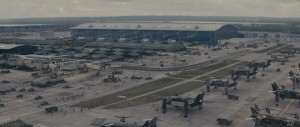 A common misconception about Hollywood is that special talent gets discovered and foisted into prominence overnight. For Kramer, becoming a visual effects supervisor in the movie industry was all about the steep and steady climb.
A common misconception about Hollywood is that special talent gets discovered and foisted into prominence overnight. For Kramer, becoming a visual effects supervisor in the movie industry was all about the steep and steady climb.
“I’ve been here since 2000,” he said. “I was a generalist at VisionArt in Santa Monica [for] eight years where I started as an intern. We worked on Independence Day, Godzilla and Deep Space Nine. We were doing a lot of commercial work, TV and eventually getting into movies. At SPI, I was a Houdini animator. I came up through the ranks.”
As a result of his 22-year tenure in Hollywood, Kramer knew the necessary expectations of going into Edge of Tomorrow. “You want to give each supervisor a sequence that stands out on its own,” Kramer noted. “The beach was such a huge component, because we had to split it across two [supervised] teams. We pulled the lighting team that fed the compositing team. Now we had compositors taking all the elements and putting them together. It’s not that big of a task considering other projects that they’ve been doing.”
Using iTView software, a digital sharing tool, Kramer established a streamlined approach that benefited the editorial process. “Nick Davis, the overall supervisor, was in London with Doug Liman doing editorial and posts,” Kramer explained. “Using our own viewing software, iTView, we remotely loaded up shots in full 2K resolution so he could see what we were doing in a controlled environment. Going through shots and getting feedback from Nick was key even though we were spread out among two different locations. The compositing team or lighting team would come in and show work that was rendered overnight – modeling, texturing, animation and lighting, compositing. We spent 8 to 12 hours in a dark room looking at images and giving feedback to teams. Most of the artists are in that room, or we are doing it through iTView synced into the same session. Artists at their desks can dial-in and be a part of the rounds. Sometimes you are talking to hundreds of artists in a remotely-detached sensory-deprived environment all day long.”
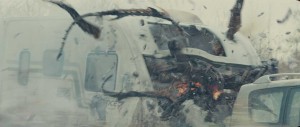 Along with using iTView as a collaborative tool, Kramer found editorial meetings amongst supervisors as the most effective way to flush out excess material. “We worked with Nick Davis in London as we presented to Doug who came to L.A. and sat in on reviews,” stated Kramer. “At one point, they get off the beach and get into a trailer park area. As they are driving through that trailer park sequence, there’s a hint that there’s some Mimics around. We built CG trailer homes to be destroyed with mimics ripping through those homes. All of that, at some point, got scrapped as they realized the movie was going [fast] the whole time. From the time they arrived on the beach to the time they got off the beach, there was relentless action which was taken out. One supervisor did the Heathrow sequence, another did the trailer park and barn sequence, and one other took over the lighting and look development. A lot of moving parts; you need superstar supervisors who can work autonomously.”
Along with using iTView as a collaborative tool, Kramer found editorial meetings amongst supervisors as the most effective way to flush out excess material. “We worked with Nick Davis in London as we presented to Doug who came to L.A. and sat in on reviews,” stated Kramer. “At one point, they get off the beach and get into a trailer park area. As they are driving through that trailer park sequence, there’s a hint that there’s some Mimics around. We built CG trailer homes to be destroyed with mimics ripping through those homes. All of that, at some point, got scrapped as they realized the movie was going [fast] the whole time. From the time they arrived on the beach to the time they got off the beach, there was relentless action which was taken out. One supervisor did the Heathrow sequence, another did the trailer park and barn sequence, and one other took over the lighting and look development. A lot of moving parts; you need superstar supervisors who can work autonomously.”
Through simple test shots and trials, Kramer worked alongside the production team to add balance to the on-screen action. In the end, he was happy with the live-action component of the production. “It was impressive to be on set,” he said. “Gas explosions, which would burn black smoke columns into the sky, mortars, air cannons filled with foam rocks and dirt. It was clear that they wanted to go over the top. When we got the first couple of shots, we tried things out and ran them by Nick Davis and Doug. We kept adding and adding. An explosion might have taken your eye away from the action, but not because it was too much destruction.”
By using his Mimic models sparingly, Kramer found that he could add a dangerous mystique, and invisible presence to the aliens while still portraying a sense of present danger in the characters. “For much of the shots, you don’t see the aliens at all,” Kramer conveyed. “The projectiles in the air were javelins shot at our soldiers – something that was unpredictable and alien. Once we came up with that look, we started littering the sky with the javelins. At any moment the guy next to you could get hit.”
When the Mimic models were in focus, bringing Sakurazaka’s aliens to life posed a unique challenge for Kramer and his team, because so many different versions of the aliens had been designed.“A lot of design work on the aliens had been done, but nothing had been settled upon,” revealed Kramer. “The early one was a quadruped with tentacles wrapped around the limbs – an alien with no solid form at all, completely made out of tentacles. This character had no specific form; there wasn’t a set number of limbs or volume for his body.”
Defying their names, Kramer designed the Mimics to be highly atypical in form, which led to some unique motion challenges. “The tentacles could reform and reconfigure into these shapes based on where it needed to go or who it needed to kill,” Kramer related “It was complicated to build and animate. Normally an alien has bones and flesh. You build that model and run it around. This wasn’t like that. We knew that the character was complicated. We had a technical animator write a plug-in to handle all of the tentacles. He devised the system which was a center curve in animation software. I wanted 20 tentacles intertwined, twisted, contracted together, to writhe against each other. The plug-in knew the radius of every tentacle. If one on the inside grew or slipped, the tentacles above it moved in reaction.”
The further implementation of project-specific software paid dividends for the project, allowing Kramer and his crew to give each graphic model a unique look.
“We gave our animator these high-level controls,” Kramer remarked. “How fast do they move? How thick are they? They couldn’t actually animate each individual tentacle. We built a body made out of tentacles and would jam these procedural limbs into the body. Each alien could be truly unique and have a different number of limbs and move independently. Along those tentacles, we would instance chains of stones or glass off of obsidian. They would look angular and sharp and use their limbs as slashing or stabbing weapons.”
Keeping the aliens faithful to the source material and Liman’s vision, Kramer sold the aliens’ remarkable speed through environmental consistency.
“Doug wanted it to really be different,” Kramer commented. “Always moving and writhing. He wanted them to move incredibly fast, subverting time and space when they move. I was worried that any time you have something moving that fast, it tends to look digital. As long as we paired it with effects animation and burst sand off of the character, it became more believable that it moved that fast and made it a little more mysterious.”
As it is no secret that visual effects outfits have to compete for projects and films, with a film the scope of Edge of Tomorrow requiring a great deal of collaboration, spreading the show amongst multiple vendors could have been tenuous. However, for Kramer, working alongside other effects companies on this film was an amicable process. “Today, more and more, vendors are rendering characters [together],” he said. “In our case, a lot of the assets that we needed were created by other vendors. We built the digital double and exo-suits for the characters. We built drop ships, Mimics, and anything that was shared. Framestore had to build a procedural system to replicate what we were doing. We sent them the digital exo-suits and [the lead characters of Cage and Rita]. We also had Cinesite who did the sparring scene shots. We shared as much as we possibly could with them and tried to be accommodating. We had a good working relationship with external vendors.”
Edge of Tomorrow is currently in general release in theaters.





